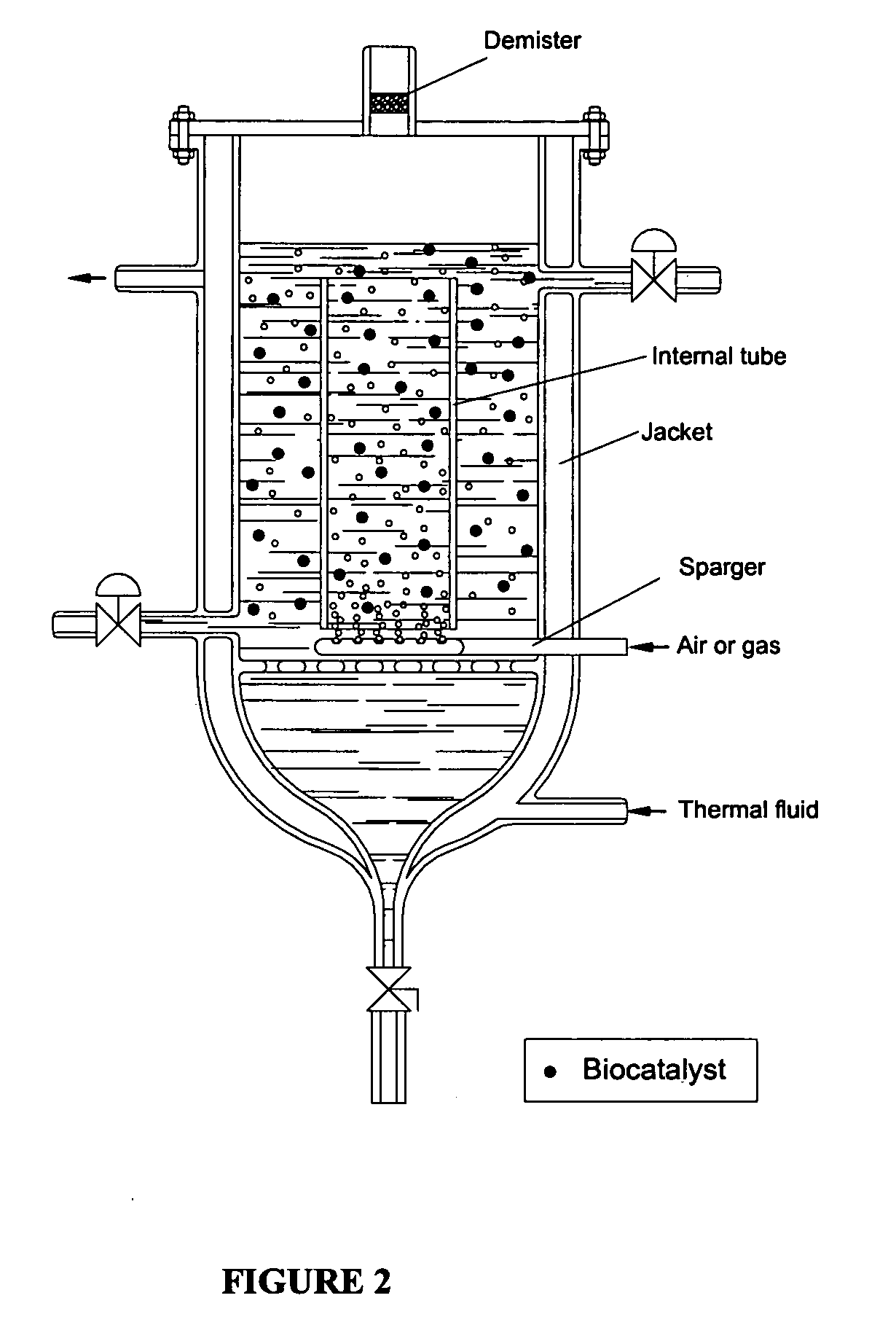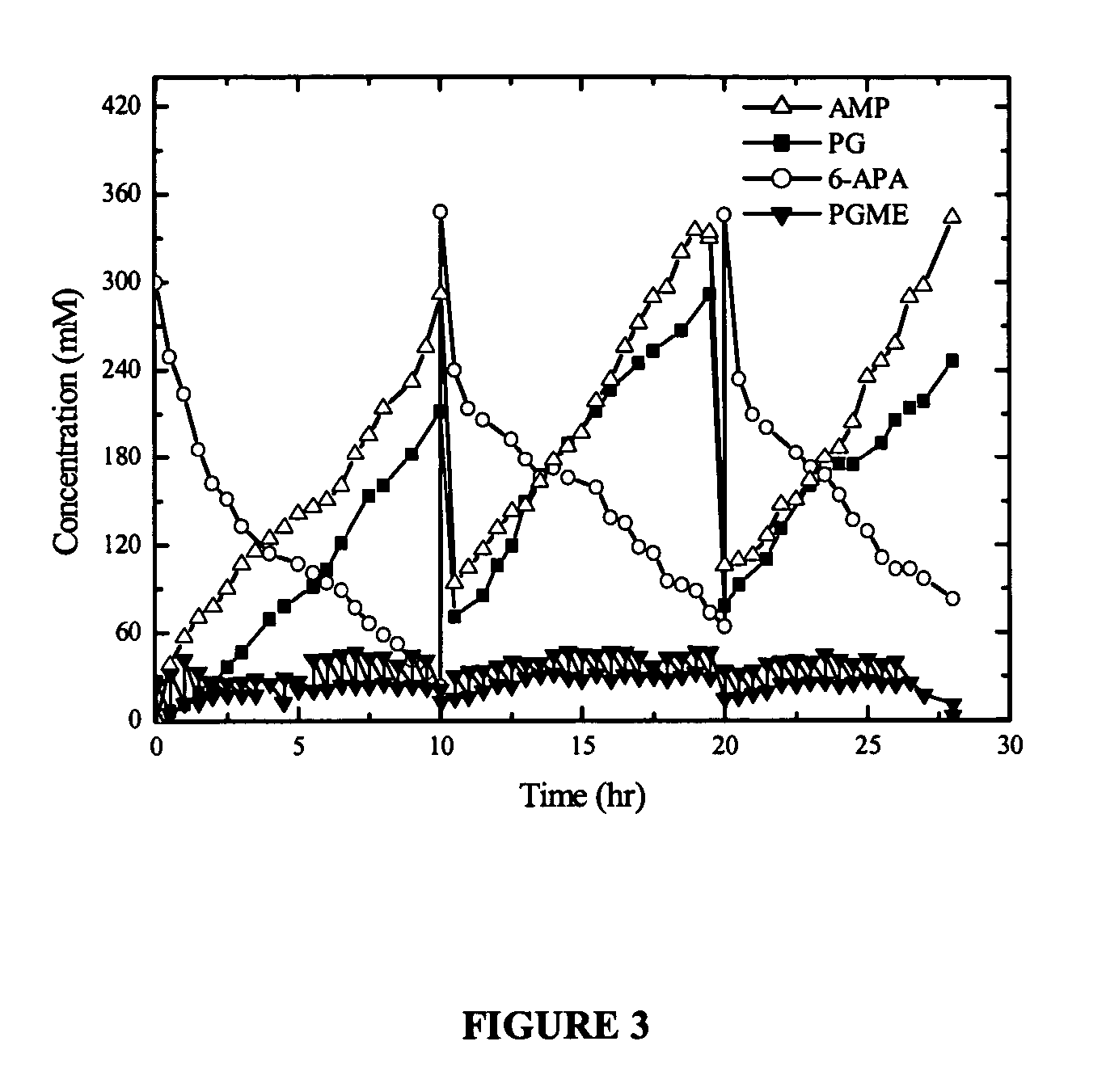Process for protection of insoluble enzymatic biiocatalysts, biocatalyst obtained thereof and bioreactor with the immobilized biocatalyst
a technology of insoluble enzymatic biiocatalysts and biocatalysts, which is applied in the field of biocatalyst preparation, can solve the problems of low economic value, inability to recycle in continuous reactors, and difficulty in separating low-dimension biocatalysts from precipitated products
- Summary
- Abstract
- Description
- Claims
- Application Information
AI Technical Summary
Benefits of technology
Problems solved by technology
Method used
Image
Examples
example 1
DEFINITIONS AND ANALYTICAL METHODS
[0060] Support—primary matrix: Agarose 10% (w / w), crosslinked, Hispanagar S / A. (Spain). [0061] Support—secondary matrix: Citric pectin with low metoxilation, type 8002, Braspectina do Brasil. [0062] Enzyme: Penicillin G acylase (PGA) from Escherichia coli [EC 3.5.1.11], Antibióticos S / A, Leon, Spain. [0063] Substrates: phenylglycine metyl ester PGME (Aldrich Chemical Co.); 6-aminopenicillanic acid, 6-APA (Winlab, obtained after the enzymatic hydrolysis of penicillin G), ampicillin (Winlab) and phenylglycine (Aldrich Chemical Co.). [0064] PGA immobilization: procedures described in the patent ES 2.005.883-A6. [0065] Enzymatic activity: 1 IU (international unity) of enzymatic activity is defined as the amount of enzyme that hydrolyses 1 μmol of penicillin G per minute at pH 8 and 37° C. [0066] Analisys: Concentrations of PGME, 6-APA, ampicillin and PG using HPLC. Column Waters C18: Nova-Pak, 60 Å, diameter 4 μm, 3.9×150 mm. Mobile phase: 35% acetonit...
example 2
[0068] Vortex flow reactor, 25° C., pH 6.5, enzymatic load 10000 IU / Lreactor. Initial concentrations: 6-APA=300 mM; PGME=25 mM. Repeated fed batch operation, feeding PGME. Time span of each run=10 h. FIG. 3 shows typical results of three successive stages. Draining time is not shown.
[0069] In this example, specific productivity reached app. 4.5×10−5 mmol / (IU.min), and absolute productivity de 0.45 mM / min. Selectivity at the end of each load was 3.6 mol antibiotic / (mol of PG). Instantaneous selectivity ranged from 3 and 6 during each stage of operation. Enzymatic activity and physical integrity of the biocatalyst remained unaltered.
example 3
[0070] Vortex flow reactor, 25° C., pH 6.5, enzymatic load 10000 IU / Lreactor. Initial concentrations: 6-APA=300 mM; PGME=25 mM. Repeated fed batch operation, feeding PGME and 6-APA. Time span of each run=10 h. FIG. 4 shows typical results of one stage.
[0071] In this example, specific productivity reached app. 3.5×10−5 mmol / (IU.min), and absolute productivity of 0.44 mM / min. Selectivity at the end of each load was 2.4 mol antibiotic / (mol of PG). Instantaneous selectivity ranged from 2 and 6 during each stage of operation. Enzymatic activity and physical integrity of the biocatalyst remained unaltered.
PUM
| Property | Measurement | Unit |
|---|---|---|
| time | aaaaa | aaaaa |
| radii | aaaaa | aaaaa |
| radii | aaaaa | aaaaa |
Abstract
Description
Claims
Application Information
 Login to View More
Login to View More - R&D
- Intellectual Property
- Life Sciences
- Materials
- Tech Scout
- Unparalleled Data Quality
- Higher Quality Content
- 60% Fewer Hallucinations
Browse by: Latest US Patents, China's latest patents, Technical Efficacy Thesaurus, Application Domain, Technology Topic, Popular Technical Reports.
© 2025 PatSnap. All rights reserved.Legal|Privacy policy|Modern Slavery Act Transparency Statement|Sitemap|About US| Contact US: help@patsnap.com



